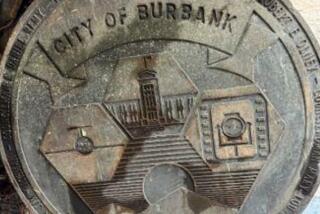Atomic Lab Theft Rife, Pair Allege
LOS ALAMOS, N.M. — A “culture of theft” at Los Alamos National Laboratory costs taxpayers millions of dollars each year and endangers national security, according to two investigators recently fired by the laboratory.
Glenn A. Walp and Steven Doran, both former police officers, say they were recruited by Los Alamos officials this year to investigate corruption at the lab, which houses the nation’s nuclear secrets and monitors the quality of the nuclear arsenal.
But after finding far more corruption than Los Alamos officials suspected -- including hundreds of missing items that could prove valuable to terrorists or rogue nations -- the investigators were handed identical letters of dismissal Nov. 25 and escorted from the laboratory by armed guards.
While becoming yet another embarrassment for the famously troubled laboratory, the firings have sparked outcries in Congress and conspiracy charges in the public.
“They’re going to rue the day they did this,” said Pete Stockton, senior investigator with Project On Government Oversight, a nonprofit group that monitors waste and fraud in the federal government. “This ranks as one of the stupidest things I’ve ever seen an institution do.”
Laboratory officials say the investigators were fired because their overly aggressive tactics and combative attitude alienated workers. But the investigators contend they were fired because their bosses cared less about safeguarding one of the nation’s most important scientific and military sites than about protecting the image of the University of California, which runs Los Alamos for the Department of Energy.
Los Alamos officials acknowledge that the FBI and the Department of Energy are looking into several leads turned up by the fired investigators. Walp and Doran say those leads include glaring lapses in security -- such as one worker who tried to buy a $30,000 customized Ford Mustang with laboratory money, and another who used her laboratory credit card to get $2,500 in cash at a casino.
UC officials said Friday that they will urge the Energy Department to widen its inquiry into Los Alamos to include the firings. “We want them to address the assertion that [Walp and Doran] may have been fired in retaliation for [their] investigation,” said Michael Reese, spokesman for UC President Richard Atkinson.
Los Alamos -- home in the 1940s to the Manhattan Project, the nation’s historic nuclear weapons program -- has been sullied in recent years by a series of security breakdowns, including the disappearance in June 2000 of classified computer hard drives that later turned up behind a copy machine, and the December 1999 indictment of Wen Ho Lee, a former lab scientist accused of leaking nuclear secrets to China.
Although nearly all charges eventually were dropped against Lee, he was found to have removed secret data from the laboratory.
“Through the years there has been ingrained within the laboratory this culture of theft,” said Walp, 61, former head of the Pennsylvania State Police who was hired to lead the internal security force at Los Alamos in January. “There is an attitude that [theft] is the price of doing business.”
Los Alamos workers joke about theft increasing around the holidays, Walp said, because some fill out their Christmas lists with big-ticket items from the lab. “The problem isn’t with scientists,” Walp said. “They’re just there doing their jobs. It’s the middle people.”
Soon after arriving at the laboratory, Walp wrote a damning report that estimated $3 million in equipment had been stolen since 1999. Among the missing items were more than 260 computers -- some from the most sensitive areas of the laboratory, where nuclear weapons are designed.
The report, Walp said, only served to irritate his bosses, who often told him that his first loyalty was to the University of California, not the U.S. taxpayer.
Los Alamos spokesman Jim Danneskiold dismissed the charge that the facility is rife with corruption. “There is no culture of theft here,” he said. “People do not walk out of here with property.”
Danneskiold said roughly one-tenth of 1% of the lab’s $1-billion inventory disappears each year, far below the percentage that large retail stores deem acceptable. Many items that appear stolen, he said, are actually stored in some forgotten Quonset hut or World War II-era shed.
Los Alamos has more than 2,000 buildings on its 40-square-mile site, he said, and things get mislaid. However, he insisted, “there is no evidence that there is any classified information on computers reported as missing.”
Although Walp and Doran considered themselves investigators, Danneskiold said, they had no “investigatory powers” and were hired to only gather information and act as “liaisons with law enforcement.”
“The reason for terminating their employment was that they had lost the confidence of different officials they had to work with, both inside the laboratory and outside,” Danneskiold said.
Doran and Walp, however, said it was absurd to expect them to retain the confidence of workers they were questioning. “It’s the most screwed-up system you ever saw in your life,” said Doran, 39, whom Walp hired at the laboratory in July. “The fox is watching the chicken house.”
Doran also scoffed at the suggestion that missing items were merely misplaced. “One of the missing items was a 2-ton magnet,” he said. “How ... do you lose a 2-ton magnet?”
Casual attitudes about missing inventory, Doran said, should raise serious doubts about the laboratory’s overall mission. “If you see the way they handle their money and their property,” Doran said, “what would lead you to believe they do any better with national security?”
Walp said he suspected that Los Alamos officials generally preferred a look-the-other-way policy when he learned that one worker caught stealing $1,800 had been asked quietly to repay the money. There was no thought of prosecuting, Walp said, although such a theft of federal property was a felony.
The most shocking case of theft, Walp and Doran said, involved two workers with access to all top-secret areas. The workers allegedly went on a brazen spree, using lab purchase orders to acquire hundreds of items, including spy gear, for reasons that remain unknown.
“It’s unbelievable,” said Doran, a former Marine and ex-police chief in Idaho City, Idaho. “They bought camping equipment, backpacks, lock picks, beacons, radio equipment, high-speed digital cameras, $9,000 worth of the best knives money can buy, tractors, lawn mowers, wood chippers, floor sanders, fencing, decks, carports, high-pressure washers, air conditioning units.”
Also, the two workers stole cryogenic freezers, which Doran said could be useful to anyone developing biological weapons.
More frightening, Walp said, the two workers would have been easy prey for blackmailers hoping to gain entry to the laboratory.
“These guys had keys to everything,” Walp said. “There wasn’t any nook or cranny in the [restricted] Black Areas they didn’t have access to. All it would take would be for somebody to walk up and say, ‘I know what you’re doing, and either you do this for me or I’m going to the cops.’
“Did it happen? Probably not. Could it happen? Yes.”
The two workers have been placed on paid leave, Los Alamos officials said, while the FBI investigates.
Doran called it unfair and insulting that workers suspected of felonies remain on paid leave, while he and Walp were summarily fired.
Also, Doran said, he and Walp received outstanding performance reviews just before being fired. Walp even got a $5,000 bonus.
Both Walp and Doran have hired lawyers and may file a lawsuit.
They also may testify before Congress. A spokesman for the House Committee on Energy and Commerce said the firings have prompted grave concern among lawmakers, who likely will hold hearings soon and send a team of their own investigators to Los Alamos in the next few weeks.
“For some time now, the committee has been quietly looking into operations at Los Alamos,” said Ken Johnson, spokesman for Rep. W.J. (Billy) Tauzin (R-La.), the committee chairman. “But these dramatic new developments clearly warrant full-scale congressional investigation.
“Frankly, the accusations are extraordinary, and we’re determined to get to the bottom of this mess.”
More to Read
Sign up for Essential California
The most important California stories and recommendations in your inbox every morning.
You may occasionally receive promotional content from the Los Angeles Times.










